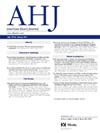Racial and ethnic disparities in longitudinal trajectories of hospitalizations in patients diagnosed with heart failure
IF 3.7
2区 医学
Q1 CARDIAC & CARDIOVASCULAR SYSTEMS
引用次数: 0
Abstract
Background
Racial and ethnic disparities in hospitalizations among heart failure (HF) patients have been well documented. However, little is known about racial and ethnic differences in the long-term trajectories of hospital admissions that follow the diagnosis of HF.
Methods
We used electronic health records (EHR) of 5,606 patients with newly-diagnosed HF between January 1, 2015 and July 28, 2018 in the Duke University Health System. Patients were followed for up to 5 years (until July 28, 2023) to identify all-cause hospital admissions after their initial diagnosis of HF. Group-based trajectory models were used to identify major trajectories of hospitalization, and multinomial logistic regression models were used to identify patients’ clinical and nonclinical characteristics associated with the trajectories of admissions.
Results
In our study cohort (mean age 74.8 ± 5.8 years), we identified 4 distinct trajectories of hospitalization during follow up: 45.6% (Group 1: N = 2,556) had “low risks” of hospitalization, 36.6% (Group 2: N = 2,052) had elevated risks of admission shortly after diagnosis (“early risk” group), 9.9% (Group 3: N = 553) had elevated risks at later stages of illness (“late risk” group), and 7.9% (Group 4: N = 445) had consistently “high risks” of hospitalization. Non-Hispanic Black patients were more likely to exhibit early risks of hospitalization (odds ratio [OR], 1.33; 95% confidence interval [CI], 1.16-1.52; P < .001), late risks of hospitalization (OR = 1.92; 95% CI, 1.58-2.34; P < .001), or consistently high risks of hospitalization (OR = 1.89; 95% CI, 1.52-2.35; P < .001) compared with non-Hispanic White patients. Diabetes, chronic kidney disease, and residence in a disadvantaged neighborhood significantly contributed to the excess risks of admissions among non-Hispanic Black patients. We found no significant differences in patterns of admissions between patients from other racial and ethnic groups compared with non-Hispanic White patients.
Conclusions
Non-Hispanic Black patients had early, late, and consistently high risks of hospitalization following the diagnosis of HF compared with non-Hispanic White patients. These findings have important implications for targeting interventions to reduce hospitalizations during the course of HF management.
心力衰竭患者住院纵向轨迹的种族和民族差异
背景:心力衰竭(HF)患者住院的种族和种族差异已经得到了充分的证明。然而,对心衰诊断后入院的长期轨迹中种族和民族差异知之甚少。方法使用杜克大学卫生系统2015年1月1日至2018年7月28日期间5606例新诊断HF患者的电子健康记录(EHR)。对患者进行长达5年的随访(直到2023年7月28日),以确定他们最初诊断为心衰后的全因住院情况。基于群体的轨迹模型用于识别住院的主要轨迹,多项逻辑回归模型用于识别与入院轨迹相关的患者临床和非临床特征。ResultsIn我们研究队列(平均年龄74.8±5.8年),我们确定了4个不同的轨迹住院期间跟进:45.6%(组1:N = 2556)“低风险”住院,36.6%(组2:N = 2052)的风险升高入学后不久诊断(“早期风险”组),9.9%(组3:N = 553)疾病风险升高到后期(集团)“后期风险”,和7.9%(第四组:N = 445)一直“高风险”住院治疗。非西班牙裔黑人患者更有可能表现出早期住院风险(优势比[OR], 1.33;95%置信区间[CI], 1.16-1.52;P & lt;.001),晚期住院风险(OR = 1.92;95% ci, 1.58-2.34;P & lt;.001),或持续的高住院风险(or = 1.89;95% ci, 1.52-2.35;P & lt;.001)与非西班牙裔白人患者相比。糖尿病、慢性肾脏疾病和居住在弱势社区显著增加了非西班牙裔黑人患者的入院风险。我们发现,与非西班牙裔白人患者相比,其他种族和族裔患者的入院模式没有显著差异。结论与非西班牙裔白人患者相比,非西班牙裔黑人患者在HF诊断后的早期、晚期住院风险始终较高。这些发现对针对性干预减少心衰治疗过程中的住院率具有重要意义。
本文章由计算机程序翻译,如有差异,请以英文原文为准。
求助全文
约1分钟内获得全文
求助全文
来源期刊

American heart journal
医学-心血管系统
CiteScore
8.20
自引率
2.10%
发文量
214
审稿时长
38 days
期刊介绍:
The American Heart Journal will consider for publication suitable articles on topics pertaining to the broad discipline of cardiovascular disease. Our goal is to provide the reader primary investigation, scholarly review, and opinion concerning the practice of cardiovascular medicine. We especially encourage submission of 3 types of reports that are not frequently seen in cardiovascular journals: negative clinical studies, reports on study designs, and studies involving the organization of medical care. The Journal does not accept individual case reports or original articles involving bench laboratory or animal research.
 求助内容:
求助内容: 应助结果提醒方式:
应助结果提醒方式:


